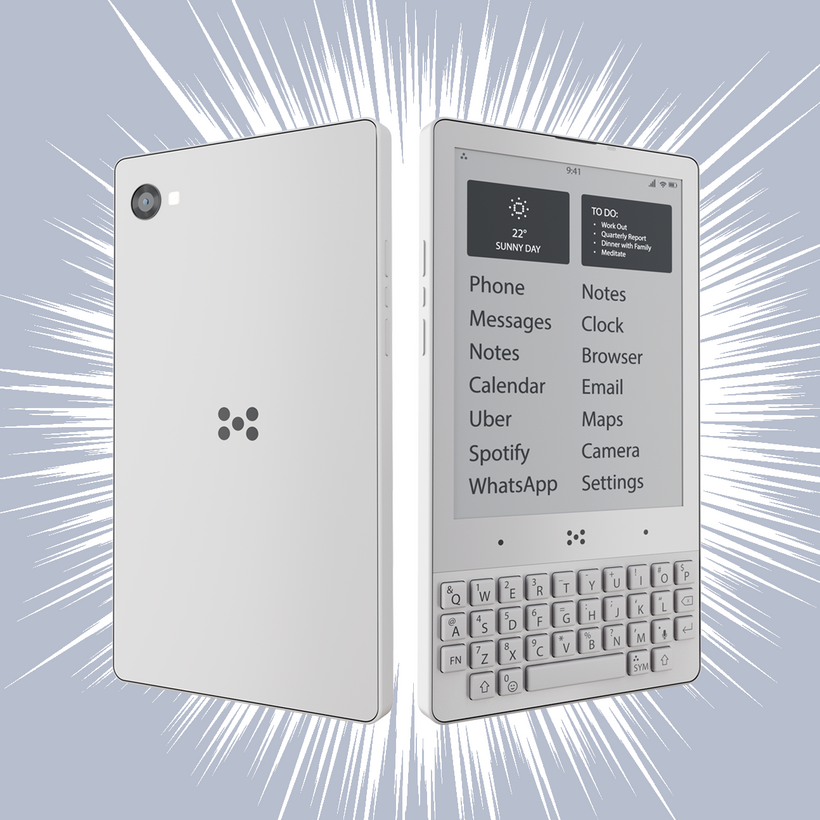The Minimal Phone
A dumbphone that’s smarter than it looks …
Your columnist used to go on long work trips with a chronic under-packer. Whatever we needed, you could guarantee she didn’t have it, while at the same time, she would laugh irritatingly at the fact that in my bulging suitcase and flight bag, I did have it.
Files, cables, connectors, pens, chargers, and water bottles were all to be found in my luggage, while Ms. Cool swanned onto flights with no carry-on bags, just a backpack and a laptop in a paper carrier, which would inevitably split as I heaved it into the overhead bin.
Proudly brandishing a dumbphone is a similar syndrome, I would suggest. “I’m so grand and important, I don’t need to use the plebeian apps you common people need,” it announces silently—while the bearer of the dumbphone asks you to order them an Uber on your account.
It’s the case that dumbphone people have a point, and, as companies such as the Los Angeles dumbphone store Dumbwireless prove, there’s a market for what the industry puzzlingly calls “featurephones,” the distinguishing feature of which is having very few features.
But other than using self-discipline, which nobody has because the stuff our smartphones serve up is so interesting, engaging, enraging, scandalous, hilarious, and often essential, we still haven’t found the right level of reliance on them. Trying to limit our addiction recently became harder still after a metastudy of 11 research projects in the journal Sleep Medicine Reviews indicated that the decade-old belief that the blue light emitted by phones interferes with sleep is probably hogwash.
Two impressive young Armenian-Assyrian cousins working in Glendale, California, have developed a very attractive new phone that might have finally struck the perfect balance between dumb and smart.
The Minimal Phone is due to ship in September, and even if it doesn’t quite succeed in the marketplace, buyers will, for $399, receive an intriguing and rare product that actually works. The founders, Andre Youkhna and Armen Youssefian, have a British chief technology officer, Simon Brooks, who has worked for Nokia and Samsung and was director of engineering at BlackBerry in its heyday.
Beyond an exceptionally neat and good-looking design, the Minimal Phone has two superb main features. It has an updated QWERTY version of the clicky physical keyboard that was on classic BlackBerrys. And it has a monochrome screen, which, in place of innumerable glowing pixels, uses low-energy-consumption E Ink, like a Kindle. The screen can be lit if you need to check something in the dark.
So the Android-powered Minimal can handle all the apps you need and all those you don’t need but enjoy, as well as play music, make video calls, and the rest. You can even take color photos, but they will appear on your phone only in black and white. It does it all, then, just in a rather more utilitarian form. And for old-school BlackBerry loyalists, typing will be much easier than on the touch keyboards that are ubiquitous on most phones today.
Minimal is possibly the smallest cell-phone company ever, with an in-house team of just five and funded by $700,000 raised on Indiegogo. If the very personable cousins succeed, and I really hope they do, it would be one of technology’s best stories.
The Radiooooo Online Radio

An addicting way to sample music from around the world across the decades …
Heaven knows the Internet offers some mesmerizing diversions, but it’s hard to think of one more distracting than an extraordinary Paris-based global Web site, radiooooo.com.
Radiooooo describes itself as “the musical time machine” and enables you to explore the musical history of most countries in the world. Click on a country and you are offered, in good streaming quality, a selection of popular music from every decade since the 1900s.
The depth of information is quite breathtaking, but the most remarkable thing is the vivid demonstration of the real culture of each country, as expressed through its popular music.
Take Afghanistan, of all places. It’s no surprise to find wonderful exotic music from when the country was open to Westerners and on the hippie trail more than 50 years ago, but one of the current Afghan songs (presumably by expat Afghans, because music is illegal under the Taliban regime) is a touching and rather good track with lyrics in English called “No Burka!,” by Burka Band.
On to Greenland. It’s hard to be sure what to expect of Greenlandic pop, but to find a selection of Greenland’s top sounds since the 1960s was a pleasant surprise. The Eskimos, Sumé, G-60, Nuuk Posse, Uyarakq, and Peand-eL—they’re all there.
It’s utterly fascinating how each country has its own pop culture, usually based on the broadly American-European pop of the era. Yet each country’s take is highly distinctive and largely unexplored by people outside that country.
The TimeChanger Watch

A watch that could one day help save your life …
Getting into the mind of watch enthusiasts has always slightly eluded this writer. The time is the time, so logically you would think that if you have a nice-looking timepiece that is accurate, you have all you need.
Nonetheless, a massive, booming global watch industry suggests otherwise. In general terms, aficionados regard the internal mechanics that make your watch tick as more important than the watch being accurate. A frustrated salesperson at the enormous Baselworld watch fair, in Switzerland, once explained to me that his wealthy customers actually prefer a glamorous mechanical watch to be a little inaccurate. “If you are wearing one of our watches,” she said, “the event starts when you arrive.”
I still laugh at this, yet in my desk drawer are a 1969 Longines given to my father by King Hussein of Jordan, a Bulova Accutron—the first electronic watch, which I bought on eBay because as a child I used to see it advertised in The New Yorker and was interested in the “tuning fork” mechanism—and a Seiko Kinetic given to me as a 40th-birthday present by Uri Geller, the self-described “mystifier” who once made his name seemingly mending people’s watches remotely. Despite their once novel movements, none of these watches keep great time.
A new watch with a wholly unique movement is temporarily on my desk. It is quirky and interesting, very pretty, and keeps perfect time. It’s designed and made in Besançon, France, which was the center of the once big French fine-watch industry.
The beating heart of the TimeChanger is a pair of miniature motors made entirely of silicon, hence the watch-geek interest in what should be a collector’s piece in years to come if you are lucky enough to buy one of the 1,088 available. The silicium machinery is unaffected by magnetism and so low-energy that a battery will last 10 years. You don’t read the time like you would on a normal watch, but it’s easy to adapt to.
So what’s the point of the 20 years of work that went into making the TimeChanger, apart from creating an interesting timepiece? It’s that the minuscule electric motor the makers have perfected—so small, power-efficient, and resilient it can be soldered to a circuit board and work for decades—has applications far beyond watchmaking, particularly in the field of medicine. Such motor-driven aids as implantable cardioverter defibrillators, left-ventricular-assist devices, insulin pumps, and cochlear implants could one day be based on this stylish and eye-catching little watch’s internal mechanisms.
The StoryPhones Foldable Bluetooth Kids’ Headphones

A charmingly old-school way to keep your kids entertained on your next trip …
In an age when children rely on screen-based diversions, the power of audio-only entertainment is easily forgotten.
When this writer’s children were very small, we did a camping trip on the West Coast. At a toy shop somewhere en route, they spotted a series of cassettes called Little Thinker, which were sound adventures narrated by a jolly woman called Nancy. One was a space journey, and the other an undersea adventure. With their eyes closed as instructed by Nancy, the kids would listen on their Fisher-Price cassette player, entranced and sedate for hours at a time. Surprisingly, the very same recordings can now be downloaded online in MP3 form for $13.99.
Little Thinker is a bit dated and a rather homemade enterprise—they didn’t respond to our requests for comment. But now there’s a slightly more up-to-date, commercial version of the same idea from a Hong Kong company, StoryPhones, which offers child-friendly headphones into which the user can slot StoryShields, small audio discs that play licensed stories from Disney and other mainstream purveyors of children’s content.
Both offerings have been enthusiastically received by our test four-year-old, and come highly recommended for anyone taking young children on trips this summer.
Based in London and New York, AIR MAIL’s tech columnist, Jonathan Margolis, spent more than two decades as a technology writer at the Financial Times. He is also the author of A Brief History of Tomorrow, a book on the history of futurology


